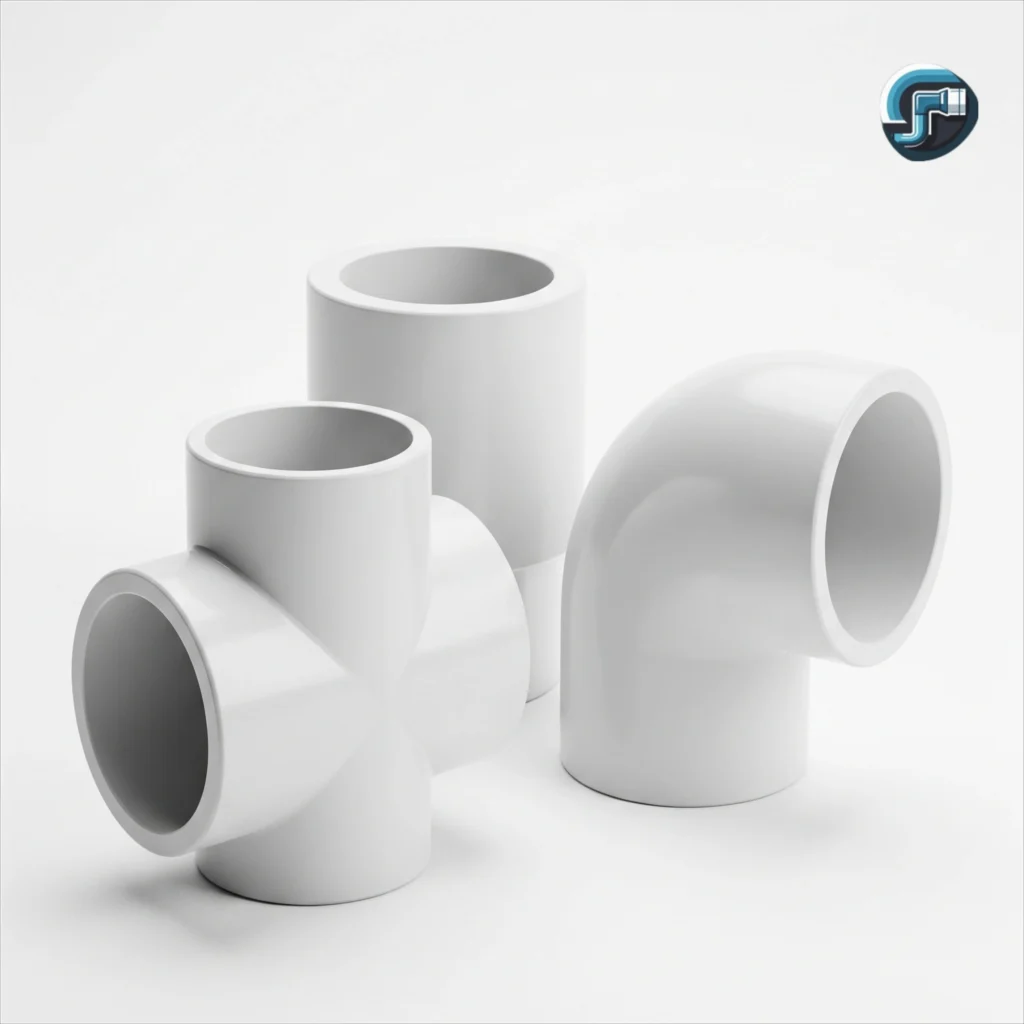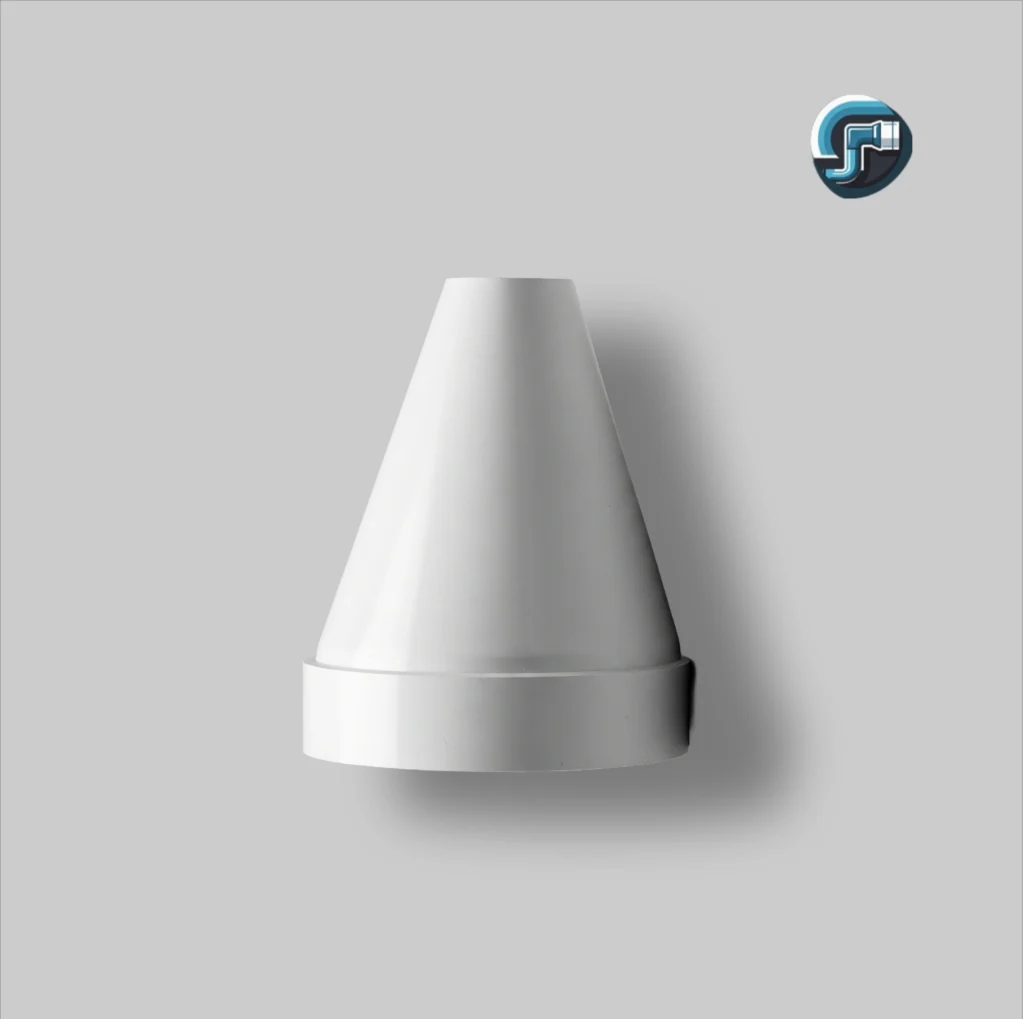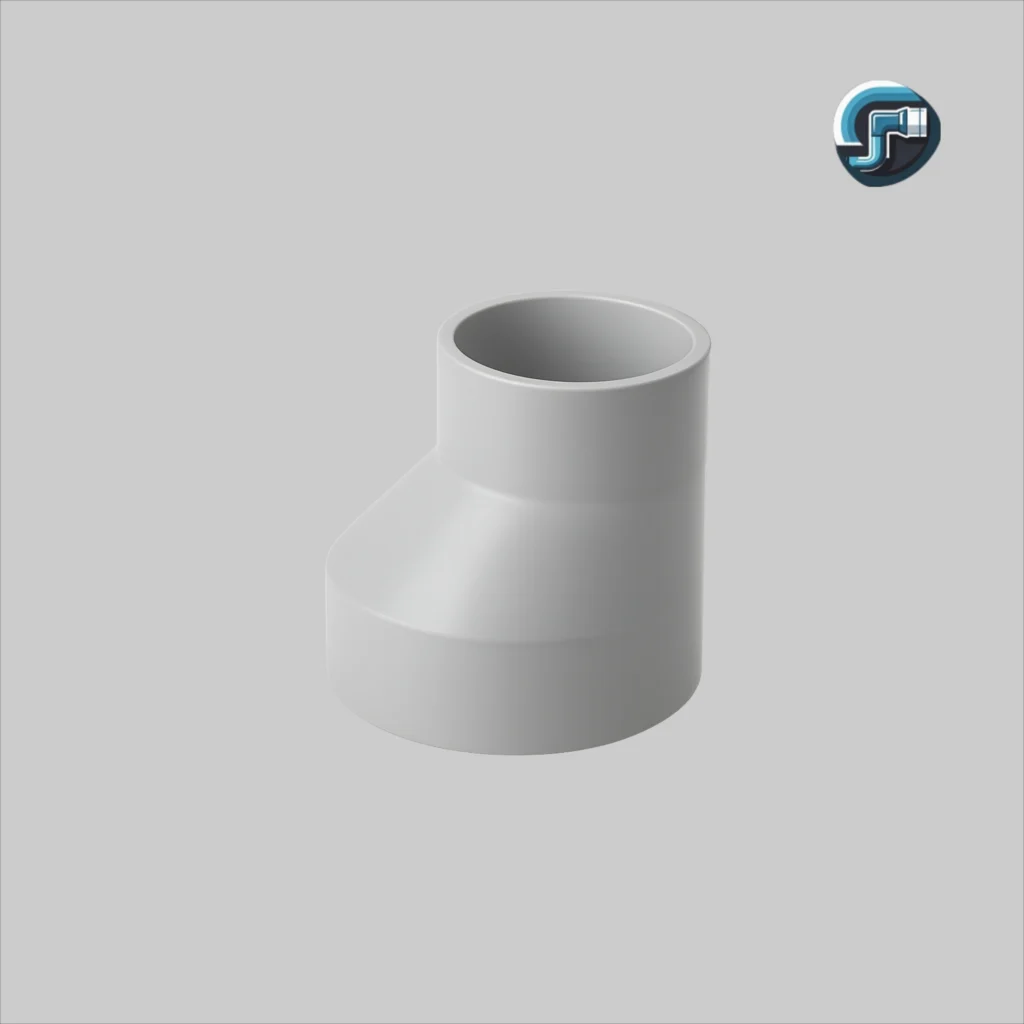PVC reducers form an integral part of piping systems since they join pipes of different definitions without either disturbing the flow or imposing any undue stress on the integrity of the system. Such fittings become extremely significant in different household, industrial, factory, and agricultural operations. Knowledge regarding various types of PVC reducers, their applications, and how to choose a suitable one is imperative for design and maintenance of any efficient piping system.
PVC reducers are special accessories used to connect pipes of different sizes easily. This gives the pipeline greater flexibility to cater to different applications. They are made from polyvinyl chloride (PVC). PVC is cheap, long-lasting, and not very prone to corrosion. These fittings assure compatibility with different pipe sizes, thereby maintaining the pressure within the system and preventing leakages. Fittings that connect two sizes of pipes must be chosen if there is an urgent need to join them for flow control, space limitations, or equipment interconnections.

Types of PVC Reducers
PVC reducers are available in different types depending on their shape and method of connection. The two main shapes are concentric reducers and eccentric reducers. Concentric reducers have a cone-like shape with both pipe ends sharing the same centerline, making them suitable for vertical piping where air pockets are not a concern. Eccentric reducers, on the other hand, have one flat side and one tapered side, which makes them ideal for horizontal pipelines, especially at pump suction lines, because they prevent the accumulation of air.
Based on the connection method, PVC reducers can be classified into socket (slip) reducers and threaded reducers. Socket reducers are joined by solvent cement and are commonly used in plumbing, irrigation, and water supply systems, while threaded reducers are designed with male or female threads for easy screw connections, making them suitable for applications where disassembly and maintenance are required.
Concentric reducers

With symmetry in profile and taper between the two pipe diameters of a centrally located axis, this is a pipe fitting for joining two different diameters. Being conical with the profile of a truncated cone, this flange will provide a nice and smooth transition between the larger diameter and smaller diameter. This is key to the operation; the smooth and even slope of the walls minimizes the abrupt changes in the flow path.
The uniform thickness of the walls, which run through the entire circumference of the fitting, gives it strength and makes the fitting robust and trusted for pressure applications. Unlike the eccentric reducer, this concentric style has proper alignment, that is, the center points of both the inlet and outlet are on the same vertical and horizontal plane.
Function
The primary function of a concentric reducer is to facilitate a diameter change in a piping system while optimizing flow dynamics. The carefully engineered gradual internal taper minimizes turbulence, frictional loss, and pressure drop as fluid velocity increases through the constriction. Such smooth transition in hydraulic terms does not allow vortices to be created and energy to be lost, which would otherwise reduce efficiency.
Installation
A concentric reducer is used in piping systems to connect pipes of different sizes while keeping the centerline of the pipe the same. It works best in vertical piping systems where air pockets aren’t a problem. To make sure the flow transition is smooth and there is less turbulence, the bigger end of the reducer should always be facing the flow inlet and the smaller end should be facing the outlet.
Concentrator reducers are generally avoided in horizontal piping, especially on pump suction lines, as they may result in an air pocket at the top of the pipe. This trapped air may cause cavitation and damage to the pump. To prevent air buildup in these circumstances, eccentric reducers with the flat side facing up are advised. However, concentric reducers are commonly used in vertical lines because gravity naturally prevents air trapping.
Depending on the type of pipe, the right joining techniques must be used during installation. When butt-welding or full penetration welding metal pipes, ASME/ANSI standards are adhered to. As directed by the manufacturer, solvent cementing, gasketed joints, or mechanical couplings are utilized for PVC or plastic pipes. Reducers must be supported to prevent sagging or misalignment and correctly aligned to prevent strain on the piping system.
The reducer and any associated pipes should lastly be examined and tested for leaks following installation; this is usually done using hydrostatic or pneumatic testing. Verifying that the reducer’s material, pressure class, and schedule satisfy the system’s requirements is also crucial. In conclusion, properly installed concentric reducers are dependable fixtures; however, for safe and effective operation, pipe orientation and flow direction must be considered.
Eccentric Reducers
An eccentric reducer has a smaller diameter on one side and a larger diameter on the other. This is because the centerline isn’t in the middle. Because of this, the design doesn’t look right. This setup is very useful for horizontal piping systems where it’s important to keep air from getting trapped or sediment from settling415.

Function
An eccentric reducer essentially serves as an obstacle for any air trap for sediment collection at the point of pipe diameter transition. Concentric reducers would generate a hump at the bottom and a pocket on the top in a horizontal pipeline. The bottom hump gets clogged up with sediment, sludge, and other solids inside and restricts the flow due to blockage. Simultaneously, the top pocket traps air and creates a vapor lock that obstructs flow, reduces efficiency, and develops turbulence.
Flat side of the eccentric reducer avoids these conditions. In case of installation with the flat side on top, it creates a smooth and level roof for traveling uninterrupted air bubbles to the next vent point. On the other hand, flat side on the bottom creates a level surface where it avoids solids from settling and allows them to be swept along with the flow.
Installation
An eccentric reducer will only function properly if installed in the correct orientation, based on the type of fluid being conveyed in the system. For systems carrying liquids (water, chemicals, sewage, etc.), the reducer should be installed with the flat side up to ensure that any air entrained in the fluid can be discharged from the system. For systems carrying gases, vapors, or steam, is should be on flat side down. This is designed to drain any liquids (condensate) that are formed by condensing the vapor to the bottom of the pipe rather than allowing it to pool in the fitting which can cause problems such as water hammer or corrosion.
Bushings that are smaller

Bushings are threaded fittings that fit into larger fittings and make an opening smaller. This makes the opening smaller so that smaller pipes can fit through. Bushings are not like other reducers because they don’t connect two pipes directly. Instead, they change the size of the fittings. They are very helpful when there isn’t enough room for regular reducers or when you need to connect pipes of different types. Their threaded design lets you make secure connections without using solvent welding in some cases, which makes installation easier.
Function
Bushings are the connecting parts in PVC pipes of various sizes. Their primary function is to tie smaller pipes to their larger counterparts by narrowing the openings in their ends. This is precisely why such items are a must-have in installations that need different pipe sizes. For example, a PVC bushing serves as a reducer between a pipe dimension of 2 inches and another of 1 inch.
In addition, these PVC bushings serve a very important function: to keep leakage tight and sealed. Snug-fit into suitable PVC sockets or fittings, therefore eliminating leaking gas, water, or other fluids from the system. This exclusive link ensures the functional safety of the piping system.
You may also make changes in the pattern of your plumbing with PVC bushes. Installers can now easily vary the size without maintaining the replacement of whole runs of piping required by using such accessories. Because of this, “down goes time and material costs.” Strong and immune to rust and chemical by-products, PVC bushings offer viability for pipes in homes, businesses, and factories.
These bushings are those parts that join PVC pipes together otherwise different sizes. Its main function is to connect a smaller pipe to its larger counterpart, to reduce the larger pipe size at its open ends. This is exactly why they are used in installations where the pipe sizes need to be different. For example, PVC bushing would reduce a 2-inch pipe down to a 1-inch pipe.
Besides this, PVC bushings will perform such a tremendous function that their connection will be tight, sealed, and definitely won’t leak. With all parameters defined for where the features should fit snug in PVC sockets or fittings, leakage of gas, water, or other kinds of fluids from the system is prevented. This connection, safely minded, will ensure the well and safe operation of the piping network.
This PVC bush will also allow you to change the plumbing layout. One such example is that PVC bushing would make the work easier for the installers as they would not have to replace whole lengths of piping if they required a different size; they could use a bushing. Hence, it brings down the cost of both time and materials. Of course, there are also very strong and immune parts against rust and chemicals: PVC bushings can be used for pipes in homes, businesses and factories.
Installation
Installing PVC bushings is a simple but important part of plumbing and piping systems, especially when you need to connect pipes of different sizes. Cutting the pipes straight and cleaning the ends so they are smooth and free of dirt and grease is the first step in getting the surfaces ready. The bushing will fit snugly into the bigger fitting and stay there once you glue it.
You should definitely use a primer if your system is under pressure. Primer softens the PVC surface and gets it ready for solvent cement, which makes the bond stronger. You should put primer on both the outside of the bushing that will go inside and the inside of the larger fitting. This step helps keep the connection strong and leak-free.
After priming, the same spots get a smooth coat of solvent cement. You need to coat both sides of the joint to make sure it sticks together properly. This means the inside of the larger fitting and the outside of the bushing. Push the bushing into the fitting as soon as the cement is on. Twist it a little to spread the glue evenly. Hold the bushing in place for a few seconds to stop it from slipping out before the cement dries.
After the smaller pipe is in place, you can use the same method to prime and cement it. Just like you did with the first connection, push the pipe in with a little twist and hold it there until the cement hardens. The last thing the maker says is that the joint needs time to dry. It usually takes 15 to 30 minutes for the system to be strong enough to handle, but it can take up to 24 hours for it to fully cure before it can be pressurized.
Making tees, elbows, and couplings smaller
Along with basic reducers, there are also special reducing fittings. Here are a few of them: Reducing couplings connect two pipes of different sizes in a straight line. Reducing tees have branch outlets of different sizes that can be used to make branching connections. Reducing elbows: When you switch between pipe sizes, change the direction of the flow.
Like reducing tees, reducing wyes have angled branches that help the flow. Connect four pipes of different sizes at right angles to make fewer crosses. Engineers and installers can use these special fittings to build systems that can handle changes in diameter in different ways. This lets them build complicated piping networks that fit in with certain flow needs and space limits.

Applications and Uses of PVC Reducers

PVC reducers are an essential part of the components in most piping systems in which they serve to join pipes of differing diameters. Their usage ranges from simple household plumbing to more complex industrial applications. Depending on the requirements of the system – especially concerning flow, whether horizontal or vertical installation, and the need to drain air or sediment, concentric or eccentric reducers are used.
Plumbing and Drain-Waste-Vent Systems
A few types of applications for PVC reducers fulfil major residential and smaller commercial purposes.
Drain Lines: Eccentric reducers are commonly used in horizontal drain lines, installed on the flat side up to ensure that the bottom of the pipe is smooth and level. Thus preventing waste and sediment from being able to settle at the transition area, causing clogs.
Vent Lines: In vertical vent stacks, concentric reducers are usually used to change from one pipe size to another without creating places where moisture can collect.
Connecting Fixtures: Reducers are used to connect larger diameter main lines to smaller diameter branch lines that feed sinks, toilets, and other fixtures.
Water Supply and Distribution Systems
Because it doesn’t rust and has smooth walls on the inside, PVC is great for drinking water.
Main Line Taps: A concentric reducer is often used to connect a bigger city water main to a smaller service line that goes to a building.
Regulating Flow and Pressure: On purpose, making the pipe smaller can help keep the pressure in a system or control the flow rates to different parts of a network.
Pump Connections: Eccentric reducers are used to connect the suction inlet of pumps. When you put them in with the flat side up, they stop air pockets from forming, which can cause cavitation, which can hurt pump impellers.
Industrial and Chemical Processing
Schedule 80 (and higher) PVC is great for handling harsh chemicals because it doesn’t break down easily.
Chemical Transfer Lines: To make sure that the connection does not leak and does not corrode, reducers are used to connect process equipment, storage tanks, and transfer lines of different sizes.
Handling Slurry and Sediment: Eccentric reducers are very important in systems that move liquids and solids together. The flat-top installation lets solids go through the reduction without settling.
Controlling Flow Velocity: Engineers use reducers to make the fluid move faster in a certain part of a process on purpose. This can be very important for some reactions or operations.
Irrigation and Agricultural Systems
PVC is the material of choice for many agricultural applications due to its low cost and durability.
- Main to Lateral Lines: Concentric reducers are used to transition from a large primary water supply line (the main) to smaller secondary lines (laterals) that distribute water across a field.
- Connecting Emitters and Sprinklers: Reducing bushings and couplings are frequently used at the point of connection for sprinkler heads, drip emitters, and other devices that require a smaller thread or pipe size.
Electrical Conduit Systems
While not for moving fluid, PVC conduit protects electrical wiring.
- Service Entry: A reducer is used where a large conduit from the main service panel transitions to a smaller branch conduit running to a specific room or circuit.
- Connecting Enclosures: Reducing bushings are commonly used to connect a conduit of one size to a knock-out hole of a different size on an electrical box, panel, or enclosure.
Frequently Asked Questions (FAQ’s)
Conclusion
Connects difference pipe sizes and helps to achieve a smooth transition from one segment to another; it has an important role to play in a plumbing, irrigation, and industrial piping system. PVC reductions are available in concentric and eccentric designs, depending on the requirement of the installations. PVC reducers are used to ensure that fluids flow evenly through the connecting piping. Their lightweight, durable, and corrosion-resistant properties have made them quite an economical choice for any piping solution lasting in the long term. Solutions applicable to building, construction, and factories wouldn’t require much effort to install, and connections could easily be accomplished as these reducers are really trustworthy and compatible with many systems – which makes them one of the most necessary fittings in modern piping networks.
